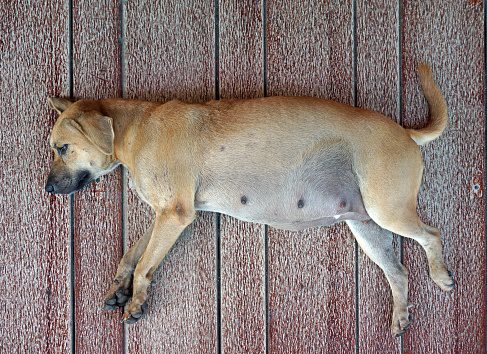
You’ve decided to breed your dog and the due date is fast approaching. If all goes well, the pregnancy and labor will progress as normal and you’ll be staring in wonder at a bunch of new puppies happily nursing from mama. However not every labor progresses smoothly so we’ve compiled a list of things to look out for.
Once you suspect your dog is pregnant, take her in to the vet. It’s important to know the due date and how many pups to expect. A typical canine pregnancy lasts for 63 days but some variation is normal. It’s recommended to call your vet if your pet is pregnant for longer than 63 days, just to be safe.
There are a few problems that may arise during labor, the most common being dystocia, or failure to progress. There are several complications that may cause this:
- The shape and size of the pelvic canal. If the pelvis is narrow, either due to breed conformation or because of a previously fractured pelvis, delivering puppies may be difficult. This is especially true if the dog has a large head relative to the size of the pelvis.
- The Breed. Breeds predisposed to dystocia include British bulldogs, French bulldogs and boxers.
- Uterine inertia can also cause dystocia. Uterine inertia occurs when the uterus is no longer able to contract and push the puppies through the vaginal canal. It can occur at any stage of labor and may be associated with uterine exhaustion.
- The size of the pups. If the puppy is too large, it will not fit in the birth canal. This can be common when there is only a single puppy in the litter.
- Puppies’ position. Puppies are normally born either head first or rear legs first. If the puppy is sideways or bottom first, they become stuck.
- Developmental defects that result in enlargement of certain body parts can make birth difficult.
- Death of the puppy in utero can result in abnormal positioning and can affect uterine contractions.

Be sure to call the vet if:
- Your dog has been pregnant for over 63 days.
- Stage I labor has gone on for 24 hours without producing a pup.
- Stage I normally lasts 6 to 12 hours – the dog will exhibit nesting behavior and her temperature will drop.
- Steady strong contractions have continued for over half an hour without producing a pup.
- Prolonged resting phase continues over 4 hours when there are more pups to be delivered.
- There is a foul smelling or bloody vaginal discharge.
- The mother-to-be has excessive vomiting or is extremely lethargic.
Treatment
Your vet will perform an examination to determine whether there are problems with the pregnant dog’s birth canal. If it seems the pups should be able to fit through, the vet may take some imaging to determine the size and shape of the pups.
- If uterine inertia is suspected, medication can be administered to stimulate contractions of the uterus.
- After prolonged labor, the mother may have low blood sugar or low blood calcium. In this case, your veterinarian will give calcium and dextrose injections which can help strengthen uterine contractions.
- If easy passage is not possible, or if medical treatment is not effective, your veterinarian will deliver the pups by Caesarean section.
The failure of labor progression is hard to prevent. Make sure you feed your pregnant dog a proper diet. Speak to your veterinarian for recommendations. Also be sure to educate yourself about the process of canine labor and look for warning signs or red flags and take prompt action. Call your veterinarian with concerns or bring the pregnant animal in if the symptoms are serious.
Bulleted information courtesy Medicanimal.com
Recent Posts
About Us
Ann Arbor Animal Hospital is a locally-owned animal hospital operating for over 90 years in Ann Arbor, MI.
